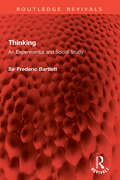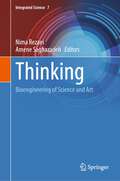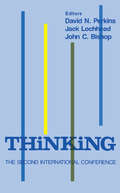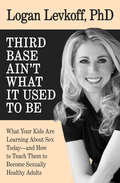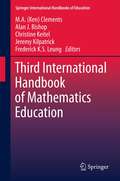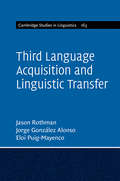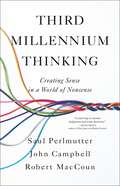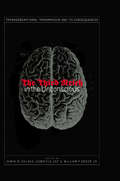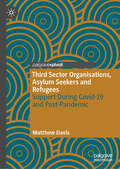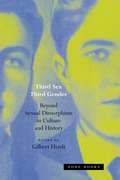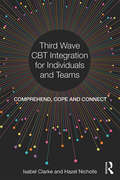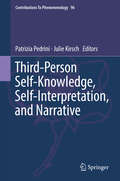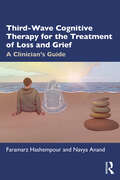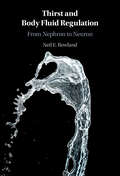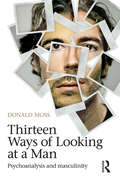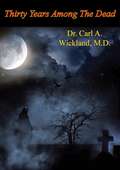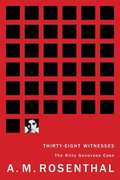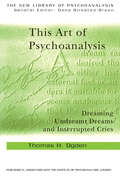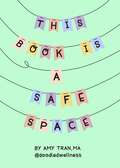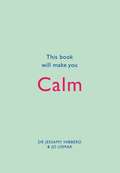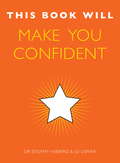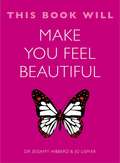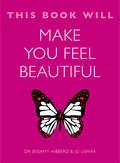- Table View
- List View
Thinking: An Experimental and Social Study (Routledge Revivals)
by Frederic BartlettFirst Published in 1958, Thinking Introduces a number of simple experiments which can all be repeated by anybody who is interested. They show that the thinker is all the time trying to fill up gaps in information that is available to him in such a manner that there is a good prospect that all other thinkers, given the same incomplete information, will agree with him. How, and what are the conditions, under which he does this, are considered and illustrated a) for formal thinking; b) for the thinking of the experimental scientist; c) for everyday thinking, and d) for the thinking of the artist.A great many of the processes used in thinking have been developed at a level of bodily skill, and long before thinking proper becomes possible at all. At the same time, it becomes clear, as the investigation proceeds, that thinking processes have important characteristics and rules peculiar to themselves. These also vary according to the fields of information in which the thinker operates. There is no doubt that Sir Frederick’s experimental study is a work of first importance and will be useful for scholars and researchers of psychology.
Thinking: Bioengineering of Science and Art (Integrated Science #7)
by Nima Rezaei Amene SaghazadehThe “THINKING: Bioengineering of Science and Art” is to discuss about philosophical aspects of thinking at the context of Science and Art. External representations provide evidence that the fundamental process of thinking exists in both animal subjects and humans. However, the diversity and complexity of thinking in humans is astonishing because humans have been permitted to integrate scientific accounts into their accounts and create excellent illustrations for the effects of this integration. The book necessarily begins with the origins of human thinking and human thinking into self and others, body, and life. Multiple factors tend to modify the pattern of thinking. They all will come into play by this book that brings thinking into different disciplines: humanities, natural sciences, social sciences, formal sciences, and applied sciences. The thinking demands full processing of information, and therefore, the book considers the economy of thinking as well. The book thoroughly intends to explore thinking beyond the boundaries. Specifically, several chapters are devoted to discipline this exploration either by artistic thinking alone or by art and mathematics-aided engineering of complexities. In this manner, the book models variations on thinking at the individual and systems levels and accumulates a list of solutions, each good for specific scenarios and maximal outcomes.
Thinking: The Second International Conference (Psychology Library Editions: Cognitive Science Ser.)
by John Bishop Jack Lochhead D. N. PerkinsFirst published in 1987. Routledge is an imprint of Taylor & Francis, an informa company.
Third Base Ain't What It Used to Be: What Your Kids Are Learning About Sex Today—and How to Teach Them to Become Sexually Healthy Adults
by Logan LevkoffRenowned sexologist Dr. Logan Levkoff&’s groundbreaking parents&’ guide for discussing sex with today&’s teenagers&“When it comes to sex, most of us are clueless,&” writes sexologist and sexuality educator Dr. Logan Levkoff. &“Yes, we know how to have sex, but we have no idea how to teach our kids about it.&” With the cultural discussion surrounding sex growing increasingly charged, Levkoff&’s insightful how-to book equips parents with the tools and perspectives necessary for navigating this complicated landscape and talking about sex with their children in a healthy and productive way. Covering everything from anatomy and puberty to pregnancy and sexually transmitted diseases, Levkoff offers the facts and candid advice that parents can use to bring their values and experiences into the discussion on sexuality.
Third International Handbook of Mathematics Education
by Frederick K.S. Leung M. A. Ken Clements Alan J. Bishop Jeremy Kilpatrick Christine Keitel-KreidtThe four sections in this Third International Handbook are concerned with: (a) social, political and cultural dimensions in mathematics education; (b) mathematics education as a field of study; (c) technology in the mathematics curriculum; and (d) international perspectives on mathematics education. These themes are taken up by 84 internationally-recognized scholars, based in 26 different nations. Each of section is structured on the basis of past, present and future aspects. The first chapter in a section provides historical perspectives ("How did we get to where we are now?"); the middle chapters in a section analyze present-day key issues and themes ("Where are we now, and what recent events have been especially significant?"); and the final chapter in a section reflects on policy matters ("Where are we going, and what should we do?"). Readership: Teachers, mathematics educators, ed.policy makers, mathematicians, graduate students, undergraduate students. Large set of authoritative, international authors.
Third Language Acquisition and Linguistic Transfer (Cambridge Studies in Linguistics #163)
by Jason Rothman Jorge González Alonso Eloi Puig-MayencoIs acquiring a third language the same as acquiring a second? Are all instances of non-native language acquisition simply one and the same? In this first book-length study of the topic, the authors systematically walk the reader through the evidence to answer these questions. They suggest that acquiring an additional language in bilinguals (of all types) is unique, and reveals things about the links between language and mind, brain, and cognition, which are otherwise impossible to appreciate. The patterns of linguistic transfer and what motivates it when there are choices (as can only be seen starting in third language acquisition) underscores a key concept in linguistic and psychological sciences: economy. Overviewing the subfields examining multilingual acquisition and processing, this book offers an expanded systematic review of the field of multilingual morphosyntactic transfer, as well as providing recommendations for the future emerging field.
Third Millennium Thinking: Creating Sense in a World of Nonsense
by John Campbell Saul Perlmutter Robert MacCounBased on a wildly popular UC Berkeley course, how to use scientists&’ tricks of the trade to make the best decisions and solve the hardest problems in age of uncertainty and overwhelming information. In our deluge of information, it&’s getting harder and harder to distinguish the revelatory from the contradictory. How do we make health decisions in the face of conflicting medical advice? Does the research cited in that article even show what the authors claim? How can we navigate the next Thanksgiving discussion with our in-laws, who follow completely different experts on the topic of climate change? In Third Millennium Thinking, a physicist, a psychologist, and a philosopher introduce readers to the tools and frameworks that scientists have developed to keep from fooling themselves, to understand the world, and to make decisions. We can all borrow these trust-building techniques to tackle problems both big and small. Readers will learn: How to achieve a ground-level understanding of the facts of the modern world How to chart a course through a profusion of possibilities How to work together to take on the challenges we face today And much more Using provocative thought exercises, jargon-free language, and vivid illustrations drawn from history, daily life, and scientists&’ insider stories, Third Millennium Thinking offers a novel approach for readers to make sense of the nonsense.
Third Reich in the Unconscious
by Vamik D. Volkan Gabriele Ast William F. Greer, Jr.The Third Reich in the Unconscious: Transgenerational Transmission and Its Consequences examines the effects of the Holocaust on second-generation survivors and specifically describes how historical images and trauma are transferred. The authors reveal the many ways in which the psychological legacy of the Nazi regime manifests itself in subsequent generations and how psychopathology, if present, can assume a number of different forms. Among the detailed case histories and treatment considerations, the text provides insight for developing strategies that will tame and eventually prevent transgenerational transmission.
Third Sector Organisations, Asylum Seekers and Refugees: Support During Covid-19 and Post-Pandemic
by Matthew DavisThis short Pivot explores the the physical, emotional, and psychological impact of the lived experiences of asylum seekers on the staff and volunteers of third sector organisations who assist and support them. This research casts a direct light on the issues, challenges, and barriers of their work during and after the pandemic. It seeks to pinpoint the needs of staff which should be addressed by employers of third sector organisations to improve efficiency and wellbeing from an operational viewpoint, a mental health lens and psychological perspective. It adopts a Constructivist Grounded Theory (CGT) — a qualitative research method that involves co-constructing theories with participants. The research effectively examines how frontline organisations need to change given the social, economic and political challenges faced by asylum seekers and refugees in accessing support alongside the impact of new Government immigration, asylum policies and new legislation at that time. It also provides insights into the lived experiences of asylum seekers and refugees.
Third Sex, Third Gender: Beyond Sexual Dimorphism in Culture and History
by Gilbert HerdtMost modern discussions of the relationship of biological sex to gender presuppose that there are two genders, male and female, founded on the two biological sexes. But not all cultures share this essentialist assumption, and even Western societies have not always embraced it. Bringing together historical and anthropological studies, Third Sex, Third Gender challenges the usual emphasis on sexual dimorphism and reproduction, providing a unique perspective on the various forms of socialization of people who are neither “male” nor “female.”The existence of a third sex or gender enables us to understand how Byzantine palace eunuchs and Indian hijras met the criteria of special social roles that necessitated practices such as self-castration, and how intimate and forbidden desires were expressed among the Dutch Sodomites in the early modern period, the Sapphists of eighteenth-century England, or the so-called hermaphrodite-homosexuals of nineteenth-century Europe and America. By contextualizing these practices and by allowing these bodies, meanings, and desires to emerge, Third Sex, Third Gender provides a new way to think about sex and gender systems that is crucial to contemporary debates within the social sciences.
Third Wave CBT Integration for Individuals and Teams: Comprehend, Cope and Connect
by Isabel Clarke Hazel NichollsThird Wave CBT Integration for Individuals and Teams: Comprehend, Cope and Connect introduces a therapy that starts from the perspective of the immediate experience of the individual. Developed by the authors, this new, transdiagnostic approach to mental health difficulties brings together the impact of past trauma and adversity on present coping (comprehend), and utilizes the latest in mindfulness and compassion-focused approaches to manage change (cope and connect).Already adopted in a variety of settings, the book demonstrates the approach’s practicality and adaptability of the therapy. The text explores the cognitive science-based theory behind the approach and its place within the range of ‘third wave’. It also includes a full manual of the linked individual and group therapy approach piloted in primary care IAPT, including case examples. The application of the approach to psychosis, its adoption in a variety of settings and the evidence base to date are also discussed. Third Wave CBT Integration for Individuals and Teams will be warmly welcomed by IAPT practicitioners looking to adopt a new, third wave CBT approach, as well as other CBT practitioners and clinical psychologists.
Third-Person Self-Knowledge, Self-Interpretation, and Narrative (Contributions To Phenomenology #96)
by Patrizia Pedrini Julie KirschThis volume answers questions that lead to a clearer picture of third-person self- knowledge, the self-interpretation it embeds, and its narrative structure. Bringing together current research on third-person self-knowledge and self-interpretation, the book focuses on third-person self-knowledge, and the role that narrative and interpretation play in acquiring it. It regards the third-personal epistemic approach to oneself as a problem worthy of investigation in its own right, and makes clear the relation between third-person self-knowledge, self-interpretation, and narrative capacities. In recent years, the idea that each person is in a privileged position to acquire knowledge about her own mental states has come under attack. A growing body of empirical research has cast doubt upon the existence of what philosophers call ‘first person self-knowledge’, i.e., knowledge about our mental states that is often thought to be immediate, transparent, and authoritative. This line of thought has led some philosophers to claim that what seems to be ‘first-person self-knowledge’ is really just ‘third-person self-knowledge,’ i.e., knowledge about our mental states that is inferential, opaque, and fallible. This book discusses challenges for first-person knowledge and explores the true nature of third-person knowledge.
Third-Wave Cognitive Therapy for the Treatment of Loss and Grief: A Clinician's Guide
by Faramarz Hashempour Navya AnandThis book proposes and explores a novel conceptualisation of the grieving process grounded in evolutionary psychology that integrates cognitive behavioural approaches such as compassion focused therapy, metacognitive awareness, and acceptance and commitment therapy. Starting with an introduction of the historical and theoretical basis for the Principles of Loss model, the book then outlines methods of assessment and describes the processes of formulation and case conceptualisation, with specific guidance on how to navigate these in the context of loss. The book provides an in-depth exploration of the Five-Phase Principles for the Treatment of Loss and Grief (intervention), as well as guidance on the supervision of loss. The chapters, accompanied by case studies, provide an overview of the novel model, followed by specific and tailor-made guidance on assessment (including a novel self-report measure), formulation, treatment, and supervision. This guide is intended for clinicians familiar with or interested in the theory and practice of third-wave cognitive behavioural therapies.
Thirst and Body Fluid Regulation: From Nephron to Neuron
by Neil E. RowlandBody fluid regulation is pivotal to human health and is served by extensive clinical and pre-clinical science. By combining modern advances with previous findings in the field, this book presents a comprehensive treatment of major experiments, theories, and new advances in the field of body fluid regulation, thirst, and drinking. It features the main integrative brain mechanisms for fluid regulation, the development of such systems, fluid balance during heat and exercise, aging and clinical disorders, and comparative aspects of fluid regulation. The volume focuses on mammalian thirst or drinking behaviour alongside relevant aspects of the physiology of fluid balance. The principal fluid compartments and their regulation by both intakes and losses are highlighted, using both human and animal studies to illustrate the main concepts.
Thirteen Ways of Looking at a Man: Psychoanalysis and Masculinity
by Donald MossImages and ideas associated with masculinity are forever in flux. In this book, Donald Moss addresses the never-ending effort of men—regardless of sexual orientation—to shape themselves in relation to the unstable notion of masculinity. Part 1 looks at the lifelong labor faced by boys and men of assessing themselves in relation to an always shifting, always receding, ideal of "masculinity." In Part 2, Moss considers a series of nested issues regarding homosexuality, homophobia and psychoanalysis. Part 3 focuses on the interface between the body experienced as a private entity and the body experienced as a public entity—the body experienced as one’s own and the body subject to the judgments, regulations and punishments of the external world. The final part looks at men and violence. Men must contend with the entwined problems of regulating aggression and figuring out its proper level, aiming to avoid both excess and insufficiency. This section focuses on excessive aggression and its damaging consequences, both to its object and to its subjects. Thirteen Ways Of Looking At A Man will be of great interest not only to psychoanalysts and psychotherapists, but also to a much wider audience of readers interested in gender studies, queer studies, and masculinity.
Thirty Years Among The Dead: Complete And Unabridged -- Obsessions And Curses Removed Through The Work Of The Medium Mrs. Wickland
by Dr Carl A. WicklandThirty Years Among the Dead, first published in 1924, details Swedish-American GP and psychiatrist Carl Wickland's experiences as a psychical researcher.After moving to California in 1918, Wickland began to turn away from conventional medical psychology and moved toward the belief that psychiatric illnesses were the result of influence by spirits of the dead. He came to believe that a large number of his patients had become possessed by what he called "obsessing spirits", and that low-voltage electric shocks could dislodge them. His wife Anna acted as a medium to guide them to "progress in the spirit world".Spiritualists considered him an authority on "destructive spirits", prompting Wickland to write this book.
Thirty-Eight Witnesses: The Kitty Genovese Case
by A. M. Rosenthal"[Rosenthal] told a stunning, tragic story and called each one of us to account for averting our eyes-- and hearts-- and voices." -Mike Wallace, 60 Minutes. It remains one of the most notorious deaths in New York City history not because of who was murdered but because of the circumstances: 28-year-old Kitty Genovese was brutally murdered, in an attack that took nearly thirty minutes and had thirty-eight witnesses... not one of whom did a thing to stop the murderer or even call for help. A.M. Rosenthal, who would later become one of the most famous and controversial editors The New York Times has ever had, was the newspaper's city editor then; the murder happened on his beat. He first published this book in 1964, the year of the murder. It is part memoir, part investigative journalism, and part public service.
This Art of Psychoanalysis: Dreaming Undreamt Dreams and Interrupted Cries (The New Library of Psychoanalysis)
by Thomas H OgdenWinner of the 2010 Haskell Norman Prize for Outstanding Achievement in Psychoanalysis! Why is dreaming the mind's single most important psychoanalytic activity? This Art of Psychoanalysis offers a unique perspective on psychoanalysis that features a new way of conceptualizing the role of dreaming in human psychology. Thomas Ogden's thinking has been at the cutting edge of psychoanalysis for more than 25 years. In this volume, he builds on the work of Freud, Klein, Winnicott, and Bion and explores the idea that human psychopathology is a manifestation of a breakdown of the individual's capacity to dream his experience. The investigation into the role of the analyst in participating psychologically in the patient's dreaming is illustrated throughout with elegant and absorbing accounts of clinical work, providing a fascinating insight into the analyst's experience. Subjects covered include: a new reading of the origins of object relations theory on holding and containing, being and dreaming on psychoanalytic writing. This engaging book succeeds in conveying not just a set of techniques but a way of being with patients that is humane and compassionate. It will be of great interest to psychoanalysts, psychotherapists and other mental health professionals.
This Book Is a Safe Space: Cute Doodles And Therapy Strategies To Support Mental Health
by Amy TranColorful Doodledwellness Illustrations to Support Mental Health and Wellness "This insightful book provides valuable paths to pursue in the search for mental wellbeing.”—Gloria Drake, Library Journal#1 New Release in Teen & Young Adult Psychology, Women Artists, and Social ScienceAmy Tran, creator of Doodledwellness on Instagram and author of This Book is a Safe Space, uses cute doodles to help you take control of your thoughts and emotions with psychology-based coping skills.Cute doodles, positive affirmations, and coping skills. Amy Tran believes cultivating a safe space in your mind and achieving balance between your thoughts and emotions begins with supporting your mental health. In This Book is a Safe Space, Amy offers cute doodles, self-love affirmations, and encouraging reminders to help you develop positive self-talk.Colorful illustrations to enhance mental health. Amy’s key to equipping you with mental health tools and tips is colorful graphics that are both visually appealing and engaging. Find positive affirmations, self-love prompts, reminders, and coping strategies.Understand brain science for a healthier mindset. Sometimes brain science and psychology can be hard to understand and difficult to navigate when building a safe space in your mind. Unlike other books about mental health, This Book is a Safe Space simplifies complex content by providing it in easily understood formats.Inside, you’ll find:Self-love affirmations, encouragement, and practical adviceCoping skills for navigating relationships and situationsTips and reminders for strengthening your inner voiceIf you liked Anxiety Relief for Teens, Mindfulness Workbook for Teens, or My Therapist Told Me to Journal, you’ll love This Book is a Safe Space.
This Book Will Make You Calm
by Jessamy Hibberd Jo UsmarLife in the 21st century is tough - new technology, constant change, more choice and extra pressure all add to our stress levels. And when you're stressed or tired your insecurities increase - so breaking that cycle feels impossible. But help is at hand: this book will show you how to beat stress and become more positive, relaxed and productive. Dr Jessamy Hibberd and Jo Usmar draw on the latest cognitive behavioural therapy (CBT) research to show you how to develop coping strategies and learn practical techniques to deal with stress and anxiety quickly and effectively. From reducing worry and boosting energy to breathing and mindfulness techniques, this helpful little book will make your life more serene, stress-free and fulfilled.
This Book Will Make You Calm
by Jessamy Hibberd Jo UsmarLife in the 21st century is tough - new technology, constant change, more choice and extra pressure all add to our stress levels. And when you're stressed or tired your insecurities increase - so breaking that cycle feels impossible. But help is at hand: this book will show you how to beat stress and become more positive, relaxed and productive. Dr Jessamy Hibberd and Jo Usmar draw on the latest cognitive behavioural therapy (CBT) research to show you how to develop coping strategies and learn practical techniques to deal with stress and anxiety quickly and effectively. From reducing worry and boosting energy to breathing and mindfulness techniques, this helpful little book will make your life more serene, stress-free and fulfilled.
This Book Will Make You Confident
by Jessamy Hibberd Jo UsmarHave you ever felt like something is holding you back? That other people seem to breeze through life, but self-doubt and insecurity prevent you getting the things you want - at work, in family life or relationships? Well, fear not: no matter how low you feel it is possible to overcome vicious cycles in your mood and behaviour. This little book will allow you to change how you think. Dr Jessamy Hibberd and Jo Usmar will provide you with the tools to build your self-esteem and realise your full potential. With practical exercises and techniques based on the very latest cognitive behavioural therapy (CBT) research, their friendly results-driven approach will give you a new sense of confidence in every area of your life.
This Book Will Make You Confident
by Jessamy Hibberd Jo UsmarHave you ever felt like something is holding you back? That other people seem to breeze through life, but self-doubt and insecurity prevent you getting the things you want - at work, in family life or relationships? Well, fear not: no matter how low you feel it is possible to overcome vicious cycles in your mood and behaviour. This little book will allow you to change how you think. Dr Jessamy Hibberd and Jo Usmar will provide you with the tools to build your self-esteem and realise your full potential. With practical exercises and techniques based on the very latest cognitive behavioural therapy (CBT) research, their friendly results-driven approach will give you a new sense of confidence in every area of your life.
This Book Will Make You Feel Beautiful
by Jessamy Hibberd Jo UsmarBody image insecurity is something a lot of us face. Overwhelming evidence suggests that constantly worrying about your appearance can stunt your ambition, cause you to feel inadequate, and make it impossible for you to enjoy your life to the fullest. Sounds familiar? There is a solution!This compact book tackles the underlying causes of body image anxiety and breaks them down so you can start to change how you view yourself and your perceived flaws. You will learn to nip destructive behaviors in the bud, stop self-criticism, and manage emotional eating habits. Dr Jessamy Hibberd and Jo Usmar employ the latest techniques in Cognitive Behavioral Therapy (CBT) to create practical exercises that can help you to take the first steps towards feeling more confident, poised, and, yes, beautiful.
This Book Will Make You Feel Beautiful
by Jessamy Hibberd Jo UsmarBody image insecurities can affect your entire life. Constantly worrying about how you look can ruin your day-to-day experiences, curb your ambitions and make you feel you don't measure up in some way. If this sounds familiar, it's time to take action. This friendly book addresses the root causes of body image anxiety and breaks them down so you can start changing how you view yourself, your appearance and any difficulties you're facing. You'll learn how to stop destructive behaviours, limit self-criticism, manage emotional eating and see yourself differently. Dr Jessamy Hibberd and Jo Usmar use the latest CBT techniques with practical exercises to enable you to build your self-esteem so you'll feel confident, self-assured and beautiful.Chapters include: Why Do We Hate the Way We Look?Cognitive Behavioural TherapyStopping Bad Body Image BehaviourFood for ThoughtJudgement DayFacing Your Fears
